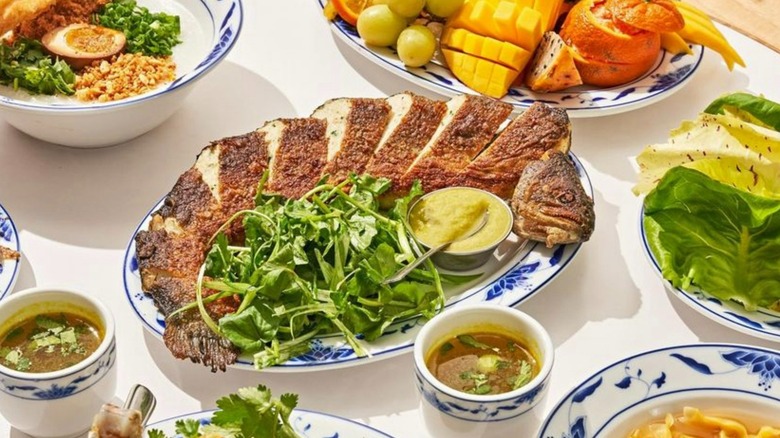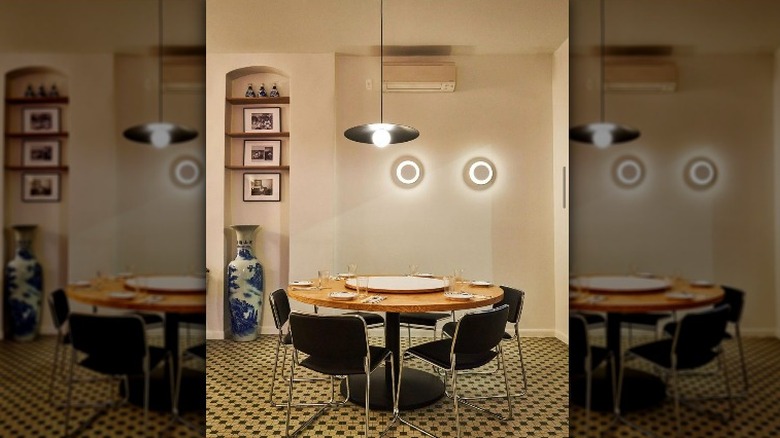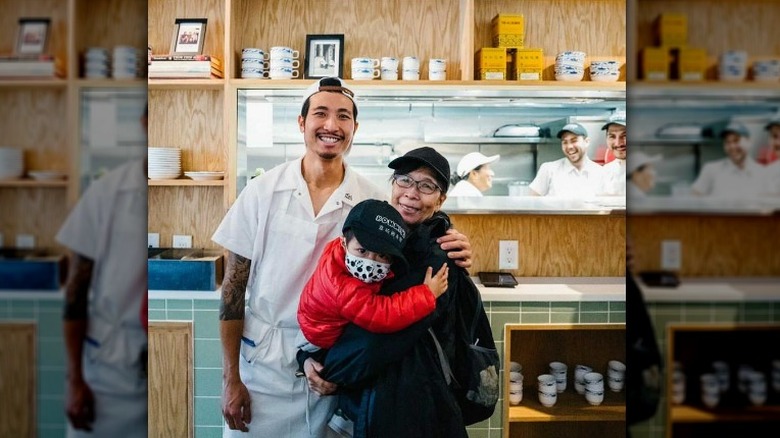Bonnie's: The NYC Restaurant That's Reimagining Cantonese American Cuisine
Chef Calvin Eng is no stranger to gastronomic and cultural fusion. The 27-year-old chef formerly served at Nom Wah dim sum in Nolita and as chef de cuisine at Taiwanese-American Win Son via The Infatuation. But, now, at his latest enterprise, Bonnie's, Eng will be the first to tell you that what he's doing isn't trying to create "fusion" food. Born and raised in Brooklyn, NY, where Eng says he "grew up trying to be as American as possible," via Bonnie's minimal yet charming website, the chef is now creating traditional Cantonese dishes using Western culinary methods. "It took a while, but I'm finally embracing the culture I once rejected growing up as a Chinese American kid." The restaurant's namesake comes from Eng's mother, whom Eng credits for his expertise in the kitchen. "I went to culinary school and worked at places, but everything I know about Chinese food is through my mom," the chef says via Grub Street.
It's this blend of identities that the chef is bringing to the table — and that hungry guests are lining up to taste. Eng was named Food & Wine's Best New Chef of 2022. His Instagram @calvinhungry is filled with photos of positive press praising both Bonnie's and the chef behind it. The restaurant opened last December, but it has already made it on America's Best Restaurants list in 2022 from The New York Times. So, what's all the hype about? And, what's on the menu?
Old meets new at Bonnie's
To build the menu, Eng started by testing recipes at local pop-ups; apparently, the method worked. Fans reportedly "followed the chef from borough to borough" for a taste, says Eater. Bonnie's menu features traditional Cantonese dishes like dao gok, savory steamed egg custard, yeung yu sang choi bao with green mustard, and fish and shrimp wontons. But, offerings also include X.O. cheung fun, inspired by Hong Kong street food, says Michelin. Old and new fans alike can dig into a reimagined Hong Kong-style macaroni soup, which replaces spam and frozen peas with mortadella and chickpeas, per Grub Street. Or, diners can dig into a whole deboned rainbow trout stuffed with water chestnuts. For dessert, guests won't find traditional Tong Sui on the menu, but they will find an avante garde fried ice cream sundae topped with buttered peanuts, pork floss, and hot fudge that tastes like Ovaltine. Prices sit around $15 to $25 per plate, which can be washed down with a wide array of $16 cocktails.
This inspired mashup of Cantonese and American culinary stylings is what Bonnie's is all about for Eng. The New York Times raves, "You could probably write a dissertation about his char siu McRib as a metaphor for the experience of Chinese immigrant families in America." The chef even created a creamy garlic-chive dressing smartly named "Chinese ranch" — a dip not for chicken tenders but for squid.
The future of Cantonese cuisine
It's no secret that New York City is one of the major metropolitan culinary hubs of the world. But, its contributions extend far beyond lox bagels or pizza by the slice. Take the subway into Manhattan's Chinatown for an hour, and you'll see what we mean. Eng agrees — and aims to breathe new life into Chinatown's culinary scene with Bonnie's. At many comparable existing Cantonese restaurants, Eng says, the owners are "getting older and retiring. The kids are in different fields and won't take over the businesses. So, eventually, the [culture] will die off. I just want to continue it and evolve it." (via The Infatuation).
That's why, when designing Bonnie's, Eng purchased most of the decor from local joints in NYC's Chinatown (per Eater). It might also be why the restaurant is located in East Williamsburg, Brooklyn, and not Chinatown on the Lower East Side: evolution of the Cantonese culinary scene. Eng might have built Bonnie's in a former office space, says Grub Street, but Michelin describes the interior aesthetic as a "retro Hong Kong diner." Reimagination — from the menu to the tables — is the name of the game at Bonnie's. Folks are clearly digging the concept. As The New York Times puts it, "The dining room is packed pretty much from the minute the doors open, which suggests that Brooklyn understands what Mr. Eng is trying to say."


